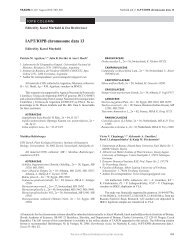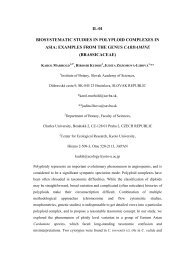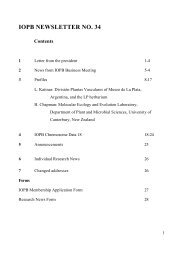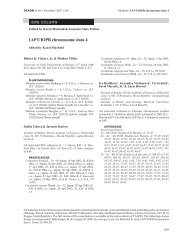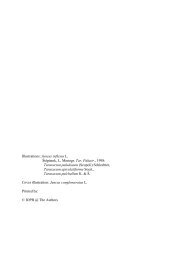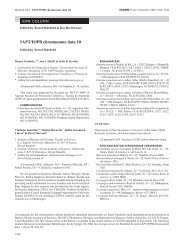CONTENS - International Organization of Plant Biosystematists
CONTENS - International Organization of Plant Biosystematists
CONTENS - International Organization of Plant Biosystematists
Create successful ePaper yourself
Turn your PDF publications into a flip-book with our unique Google optimized e-Paper software.
O 49<br />
Apomixis in Taraxacum: European and Himalayan taxa from the<br />
cytogenetic viewpoint<br />
Radim J. Vašut 1,2 , Kitty Vijverberg 3 , J. Hans de Jong 2 & Peter J. van Dijk 3<br />
1 Department <strong>of</strong> Botany, Faculty <strong>of</strong> Science, Palacký University, Šlechtitelů 11, CZ-<br />
78371 Olomouc, Czechia; 2 Department <strong>of</strong> <strong>Plant</strong> Sciences, Laboratory <strong>of</strong> Genetics,<br />
Wageningen University, Arboretumlaan 4, NL-6703 BD Wageningen, the<br />
Netherlands; 3 Keygene N.V., P.O. Box 216, 6700 AE Wageningen, the Netherlands.<br />
The genus Taraxacum (dandelion; Asteraceae) combines three modes <strong>of</strong><br />
reproduction: two sexual ones (allogamy, autogamy) and apomixis. Autogamy is<br />
known only in few ancestral taxa, whereas apomixis is widely distributed across all<br />
continents and it covers most <strong>of</strong> phylogenetic groups <strong>of</strong> the genus. The dandelion’s<br />
type <strong>of</strong> apomixis is diplosporous apomixis and it is confined to polyploids (mainly<br />
triploids and tetraploids). One <strong>of</strong> three genes involved in its regulation is Diplospory<br />
(DIP; first division restitution meiosis). We physically positioned DIP region to middle<br />
<strong>of</strong> distal arm <strong>of</strong> one <strong>of</strong> the NOR chromosome in apomictic common dandelion (T.<br />
sect. Ruderalia). In this study, we therefore aimed at answering the question: a) what<br />
is the position <strong>of</strong> DIP region in other apomictic Taraxaca from different geographical<br />
regions, b) not related phylogenetic groups and c) <strong>of</strong> different genome-size. In<br />
addition, we studied NOR chromosomes in autogamic taxa. We address the<br />
question, whether this can explain origin <strong>of</strong> apomixis. We used Fluorescence in situ<br />
hybridisation (FISH) with BAC probes containing DIP-linked SCAR markers. In<br />
autogamic species, increased number <strong>of</strong> NOR chromosomes was observed. In<br />
apomictic taxa, the same position <strong>of</strong> DIP region in all our studied sections was<br />
confirmed. We detected either unique strong signal or signal significantly larger then<br />
remaining signals located in the middle <strong>of</strong> distal arm <strong>of</strong> one <strong>of</strong> the NOR<br />
chromosomes. This indicates that DIP region has conserved position in the genus<br />
Taraxacum and apparently has longer evolutionary history then apomictic taxa<br />
themselves.<br />
50



